![]()
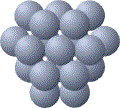 THE QUANTUM SPACE
THE QUANTUM SPACE
Aldo Piana
Part IV
The gravitational Waves in quantum space. Their origin, characteristics and performances.
PART IV : CONTENTS
21) THE GRAVITATIONAL WAVES
(To PART II)
![]()
THE GRAVITATIONAL WAVES
![]()
In
spite of the many attempts made, in spite of researchers’ efforts and the
use of complex, highly sensitive equipment, gravitational waves, predicted by
relativity,
still have not been revealed, except for few rather unreliable
indications.
However,
are we certain that they are searched for in the right places and in the right
ways, and that everybody means the same thing by gravitational waves?
In
order to understand the reasons causing difficulties in this kind of search,
to explore any alternative investigation available and to make sure that no
misunderstanding exists about the subject of this research, I believe it will
be useful to completely re-examine this topic, starting from the ways
gravitational waves form, up to the action they perform. This analysis is
obviously made in the framework of quantum space theories, but many
considerations can also apply to other contexts, with an appropriate translation.
In
quantum space, mass is hypothesized as a halo surrounding material particles.
The halo, made up of a shell of small-sized space quanta “contaminated” by
the particle’s energy, will interact with space, thus determining its
curvature. In other words, mass behaves like a gas bubble in a liquid; the
bubble displaces the liquid’s molecules, causing them to arrange themselves
spherically around it.
For
complex objects, the curvature imprinted on space is equal to the sum of the
curvatures determined by all constituent particles, but in this case it is not
a perfect sphere, but rather an overlapping of spheres, each centered on a
constituent.
Thus
space will acquire an unlimited
pseudo-spherical
configuration, centered on the particle or on the object, a sort of
“gravitational bubble” which interacts with the curvature imprinted on
space by nearby bodies, determining as a whole the spatial geometry in which
objects move.
Obviously
the influence each object exerts on geometry as a whole is proportional to its
mass.
The
objects however are in motion along the track determined by space geometry
itself. The track they follow, seen from the object as a straight line, from
the outside looks like a circular or elliptical orbit, or less frequently like
another curve of the family of conic sections, which follows the curvature of
space determined by the body around which the object revolves. From a greater
distance, when the observation field includes a higher number of objects, the
track will first look like a cycloid, then like an overlapping of cycloids of
increasingly large size.
The
orbits’ tracks however are not as regular as they may seem at a first
observation, because they exhibit imperceptible irregularities not only caused
by the irregularities of curvature itself, as pointed out before, but also by
the fluctuation of the geometrical configuration; more precisely, they shall
be considered as statistical successions of all the positions the moving body
can take in a given time frame. The smaller the object, the larger orbital
irregularities determined by the geometrical configuration will be.
The
object’s motion along its orbit corresponds to the orbital shift of the
relative “gravitational bubble” which in turn produces a gravitational
perturbation on surrounding objects in the form of waves. The wave’s
frequency corresponds to the orbital period: it is extremely high for
elementary particles, (in quantum space with a stepwise digital track, rather
than continuous analogical profile) and it rapidly decreases as the bodies’
size and complexity increase.
Moreover
the gravitational wave produced by a complex object exhibits a profile which
retains the trace of the waves generated by the mutual motions of all its
constituents; the total wave is the sum of all concurrent waves.
A
peculiar characteristic of the gravitational wave produced by bodies in
orbital motion is its spatial distribution. The wave does not propagate
spherically; it exerts the strongest perturbations in a sinusoidal way on the
bodies lying on the rotation plain of the object that generates it. The bodies
lying near the rotation axis instead will only be subjected to a disturbance
which tends to cause their rotation axis to oscillate with a precession
pattern.
Intermediate
positions are characterized by a combination of sinusoidal and precession
perturbations, according
to the perturbed object’s angular position on the rotation plain of
the body generating the wave. Setting aside the detection difficulties for a
moment, the wave’s degree of polarization could provide precise indications
regarding the orientation of the body that generated it.
Bodies
in orbital motion however are not the only source of gravitational waves: any
mass variation in a given region of space is at the origin of gravitational
perturbations on external bodies. It follows that explosion, expansion,
collapse and mass-energy conversion events, as in supernova explosions, will
lead to the most intense gravitational perturbations; their undulatory pattern
is however highly irregular, whereas violent mass-energy conversion will
generate negative, brief impulses
restricted to the time taken by conversion.
In
such cases the spatial distribution of gravitational impulses will be
spherical in the event of mass-energy conversions and homogeneous explosive
expansions, and irregular in the event of expansion made inhomogeneous by
varying waves of densities.
Gravitational
waves produced by supernova explosions are the most intense, but also the
hardest to detect because of their duration and irregularity patterns, and
because of the overlapping of waves with extremely diverse frequencies
and phases at negative impulses. Moreover, the presence of a background
of waves coming from every object in the universe which permeates space makes
their identification even more difficult.
Sufficiently
intense and regular gravitational waves can be generated by double-star or
multiple-star systems, which are present in high percentages (estimated at
almost 50%) both in the Milky Way and in other galaxies. Pairs of stars which
differ greatly in mass, type, and age
are not suitable for the study of the gravitational waves they produce,
as they exhibit complex interaction phenomena which strongly alter their
behavior. Pairs of stars with equal mass and characteristics instead
constitute the ideal object of study.
One
of the systems that has been studied for a long time is the pair of coalescent
neutron stars PSR 1913+16, one of
which is a pulsar, discovered by Taylor and Hulse in 1974 and observed for
nearly two decades with the arecibo
radio telescope.
The
PSR 1913+16 pair is composed of two neutron stars - each with a mass of 1.4 M$ (solar masses)
approaching
the black hole limit, with an
estimated diameter slightly over 10 km – which revolve around their common
center of mass with highly elliptical orbits at a mutual distance of about
770,000 km at periastron and about 3,340,000 km at apastron. The orbital
period is about 7 hours and 45 minutes long.
The
prolonged observation has allowed the determination of the pulsar’s
revolution around the periastron, similarly to the advancement of Mercury’s
perihelion, perfectly in line with relativity’s predictions. The advancement
of the pulsar’s periastron is 4.2 degrees per year: in only one day it
equals Mercury’s perihelion’s shift in one century.
But
the system’s most relevant feature is the orbital period’s decrease of 76
milliseconds/year, which presumably indicates a loss of energy attributable to
the emission of gravitational waves. The decrease of the orbital period and
the consequent contraction of the orbit will cause the two stars to merge in
about 300 million years.
The
PSR 13+16 pair therefore seems to be a possible source of intense and
regular gravitational waves which should be relatively easy to pick up with
the new detectors under construction (Virgo
in Medicina, Ligo at Hanfor and
Livingston, and others currently designed or under construction in Japan and
the space interferometer LISA with a base of 5 million km scheduled for 2010),
especially if used in combination.
It
must however be pointed out that the more elusive waves that these instruments
will try to detect are not exactly the gravitational waves which originate in
the ways discussed above, but rather an effect they cause.
We
must then distinguish between the gravitational perturbation exerted on
surrounding objects by accelerating masses (or orbiting masses, which is the
same thing) and space-time contracting or expanding oscillations stemming from
the perturbations, i.e. the “waves” predicted by relativity.
A recent work carried out at the
Department of Physics
and Astronomy SUNY, Stony Brook, NY, emphasizes this distinction and suggests
that it may be incorrect to use the term gravitational waves to define
structural oscillations of the space-time. Below is their complete statement:
"The gravitational radiation is itself the changes in the structure (or mathematically "metric") of the space-time. This is a crucial point in the phenomenon of Gravitational Radiation, but perhaps it is wrong to call these changes in the structure of space-time as waves or radiation."
To
avoid any misunderstanding we may then speak of “gravitational waves” and
“relativistic gravitational waves” still making sure that their
characteristics, formation modes, and effects remain clearly distinct until
they overlap.
We
don’t need to go too far to find gravitational waves intended as
perturbations of the gravitational field caused by nearby masses in motion:
tides are the product of the
gravitational interactions between the Earth and the Moon, with consequent
emission of an undulatory perturbation. We shall not forget moreover that
tidal effects lead to a transfer of rotational energy which in this case has
slowed down the Moon’s rotation until it became synchronous to its
revolution period.
In
the PSR 1913+16 system, both the reduction of the orbital period and the
induced space-time distortion can also be considered to be tidal effects.
Until the system’s influence on the motions of nearby bodies is not
ascertained, we will not be able to exactly understand the ways energy is
transferred, also because when a body exerts a gravitational influence on the
motion of other objects it will receive an influence of the same global intensity.
A
more daring extension of this hypothesis, but one substantially in line with
relativity’s essential definition of gravitation as the curvature of
space-time, and not as a force, states that no energy release through
gravitational waves occurs; if energy loss is detected within the system, this
should be attributed in a more traditional fashion to the emission of
electromagnetic radiation or jets of matter. So, let’s see how the observed
effects may be explained.
An
accelerated mass will determine a deformation in the curvature of the space in
which nearby objects move, thus modifying their orbits. These will in turn
modify the curvature of the space in which the accelerated mass moves, fitting
its orbit to the new geometrical configuration; in the case of PSR 1913+16 by
reducing the orbital period. The orbital period’s reduction corresponds to
the decrease of the orbit’s medium radius and the increase in rotational
speed, but the angular momentum remains constant, with no gravitational energy
transfer. Being
![]() and
and ![]() the orbit’s initial values and
the orbit’s initial values and![]() and
and ![]() the successive values, we obtain
the angular momentum per mass unit l
:
the successive values, we obtain
the angular momentum per mass unit l
:
![]()
An
extremely relevant consequence rules out that the modifications of the space
curvature induced by an accelerated mass on surrounding bodies and the
adaptation of the curvature near the mass may occur in succession at finite
speeds, imposing their synchrony. A delay between the produced modification
and the return reaction would cause a gravitational and energetic unbalance
with catastrophic consequences.
But
even if they do not transmit energy directly, gravitational waves change the
paths of objects, particles, and energy exchanges, so that the apparent
effect is analogous. In other words, an object can be moved by applying
a force onto it, or by re-shaping the path along which it is moving, obviously
causing it to shift direction or to change speed.
If
some form of energy is needed to operate such changes in space geometry, this
energy is yet to be discovered, and we currently have no clue as to what it is like.
In
any case, the search for relativistic gravitational waves looks like a nearly
desperate enterprise, not just because of the extreme faintness of their
signal, but mainly because of their overlapping with the background noise
(space is permeated by waves of the same type coming from every object in the
universe) which makes it hard to detect such signals. And even after a signal
is picked up, it will be extremely difficult to determine where it comes from
and to associate it to an astronomical system or event. Some indications may
be obtained by comparing the signals of different detectors, or from the
characteristics of frequency, polarization, and intensity of waves emitted by
systems whose structural features are already known.
To
better comprehend the action orbiting masses exert on surrounding objects, and
to assess their actual entity, I have carried out some quantitative tests on a
hypothetic pair of neutron stars, similar to the PSR 1913+16 pair but
belonging to a theoretical system in which masses, orbits, and the features of
the two stars are not altered by different origins or by correlated
astronomical events.
The
system would exhibit the following characteristics:
·
Mass of each
of the two stars m1
= 1.4 M$ (solar masses) equal to ![]() kg.
kg.
·
Radius r1 (distance from the center of mass) of the perfectly circular orbit 1,000,000
km.
·
Distance d1 from Earth 250
light years equal to ![]() km.
km.
Figure AA
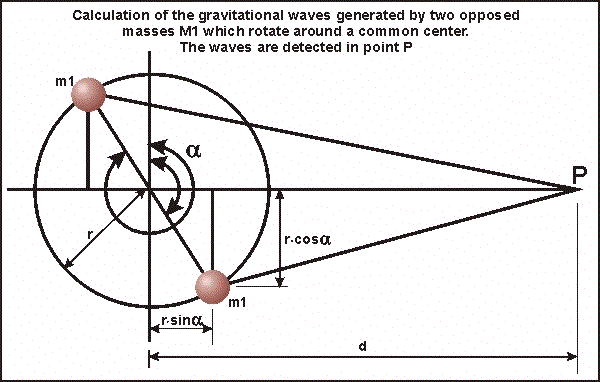
The calculation verifies the oscillations
of an equivalent virtual mass
![]() , (by equivalent virtual mass we mean the mass that a hypothetical body would
have if placed in the spot where the gravitational effect is measured which
would produce the same effect of one or more distant bodies).
, (by equivalent virtual mass we mean the mass that a hypothetical body would
have if placed in the spot where the gravitational effect is measured which
would produce the same effect of one or more distant bodies).
![]() measured in point P has the value:
measured in point P has the value:

and for a complete rotation of the system,
the equivalent virtual mass will exhibit the oscillation shown in the curve
below. Masses are expressed in kg and distances in km; the oscillation is
considered with respect to the continuous base value given by:

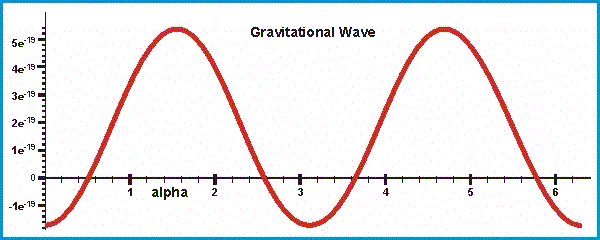
Two
very important considerations stem from these simple calculations, the first of
which concerns the influences of field oscillations on the value of the
gravitational constant. In fact, if we determine the value of the virtual mass
![]() in points M1v.A
and M1v.B,
which represent two bodies placed at a mutual distance of 10 m and centered on
point P
(see figure BB below), we will observe an oscillation of the virtual mass’s
value of
in points M1v.A
and M1v.B,
which represent two bodies placed at a mutual distance of 10 m and centered on
point P
(see figure BB below), we will observe an oscillation of the virtual mass’s
value of ![]() kg, still with respect to the base
value of
kg, still with respect to the base
value of
![]() kg.
kg.
The
virtual mass will alter the mass of an object moving with respect to the two
surrounding objects with an effective mass constituted by the sum of the two
masses, the real and the virtual one. The gravitational constant
G, derived
from the force of attraction F measured between two bodies of masses m1
and m2
placed at a distance of:

thus
becomes a variable independent of the oscillations induced on masses
m1 and m2.
Under
normal conditions and at normal distances the values at play are so small that
they are irrelevant, and any effect they may cause can only occur within time
frames as long as the predicted age of the universe, or even longer. But in
galactic nuclei, like in any other setting with an extremely high massive
concentration, or in extrapolations on cosmological scales, the role of the
variable G may become so relevant that any assessment error can be misleading.
Figure BB
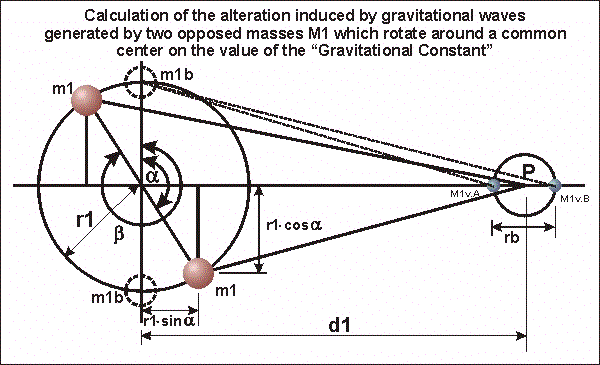
Another
equally relevant consideration concerns the origin of relativistic gravitational
waves, i.e. of the metric oscillations of the structure of space-time produced
by the motions of accelerated masses.
In this case, deriving d from the equation for the determination of
G and multiplying it by the ratio between
gravitational force and electromagnetic force, we will obtain ![]() , i.e. the metric variation of space-time produced by the tidal effect on the
distance d.
, i.e. the metric variation of space-time produced by the tidal effect on the
distance d.
This way, the perturbation of the
gravitational field not only affects the bodies’ mutual positions, but also
acts on the very structure of matter.

The search for relativistic gravitational
waves with big interferometers however should not lead us to underestimate
laboratory experiments, which can be carried out at a lower cost and with fewer
resources. Clearly, in a laboratory it is not possible to detect relativistic
waves, i.e. the metric distortion of the space-time, which can only be derived
theoretically from the determination of the equivalent virtual mass.
The hypothetical system for laboratory
trials is structured as in Figure AA, with two masses m1a of 2000 kg each, radius r1a of 10 meters, distance d1a of 100 meters.
The equivalent virtual mass measured in Pa exhibits a continuous base value of 0.4 kg whereas the wave has a peak value of 0.0162 kg.
Laboratory
trials would also allow to test other gravitational characteristics, such as the
patterns in which the space curvature produced by a mass will follow this mass
as it moves through space. To my knowledge, such a test has never been carried
out so far. Let us discuss what should be verified, and why this research is so
essential.
Gravitation
is not determined by classic forces, but by space geometry which configures the
bodies’ orbits. In detail, in a system like the one portrayed in figure CC 1
the star S will curve the space within which planets A and B move, thus
re-shaping their orbits; the planets in turn influence space, thus perturbing
the star’s orbit.
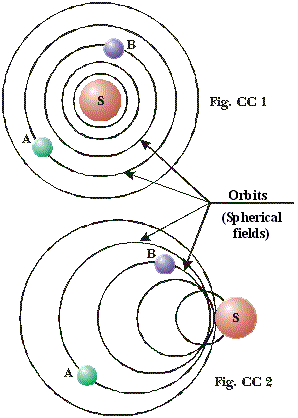
The
star S however is itself moving along a galactic orbit, or along an orbit of the
higher system that comprises it. The Sun, for instance, moves along the galactic
orbit at about 230 km/s, our galaxy is moving at a speed of approximately 600
km/s in the Local Group, while the Local Group is in turn approaching the
“Great Attractor” at an estimated speed of about 2000 km/s. All these speeds, with respect to
any external system of reference, may add or subtract according to the orbital
position.
In
order for planets A and B to maintain their orbits around the star S, the
curvature of space imprinted by the star must follow it synchronously. If the
curvature, or more precisely the gravitational field, was influenced at a finite
speed, the two planets A and B would end up orbiting in a decentralized space
because of the delay with respect to the star, entering a spiral orbit which
would eventually cause them either to fall onto the star or to be expelled from
the system, as shown in figure CC.
Laboratory
experiments - for which the proposed system is only one of the settings we could
use to evaluate obtainable results – if properly designed and done with the
most up-to-date equipment, should allow the relatively easy verification of
gravitational interactions which govern the structure of our universe.
![]()